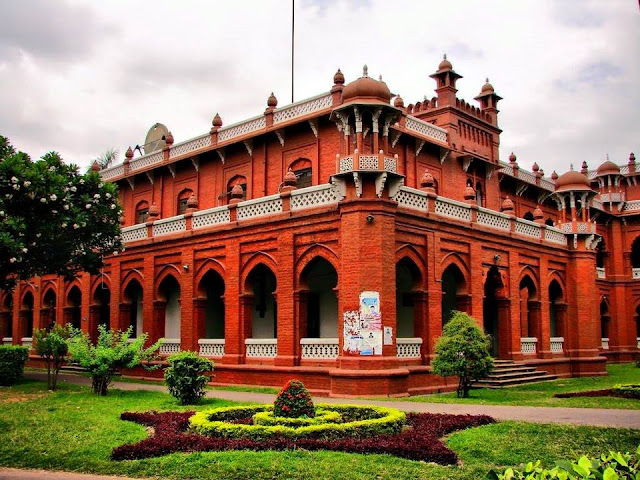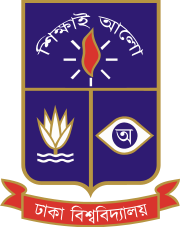 | |
| University of Dhaka | |
 |
| DU LOGO |
ঢাকা বিশ্ববিদ্যালয় (Dhaka University or DU) is the oldest university in Bangldesh. It is situated at the capital city of Bangladesh.It has started its journey in July, 1921.
A Muslim delegation led by Nawab Sir Khwaja Salimullah Bahadur, the then Nawab of Dhaka demanded a University be set up in Dhaka. To appease the majority Muslim masses of East Bengal, Lord Curzon agreed and declared that a university as a center of excellence would be established in Dhaka. Nawab Sir Khwaja Salimullah, the Nawab of Dhaka, who played a pioneering role in establishing the university in Dhaka donated 600 acres of land from his estate for this purpose.
International ranking
In 2011–12, the University of Dhaka made it into the list of 'Top World Universities' by QS World University Rankings. Out of over 30,000 universities around the world, DU was placed at 551.In 2014–15, the University of Dhaka was ranked 701 by QS World University Rankings (formerly Times Higher Education–QS World University Rankings). In 2015–16, Times Higher Education partnering with Elsevier ranked the university at 654th position among top 800 globally reputed universities.In September 2015, QS World University Rankings published their 2015 edition of World University Rankings of 2015/16 and ranked DU at 126th position in Asia and 701-750 position in the world. In 2018 QS World University Rankings, University of Dhaka is ranked in #1300 globally, and based on Graduate Employability, University of Dhaka is placed in #1000+ in the world. In Times Higher Education 2018 Global University Ranking, University of Dhaka is placed in 1001+ position among the world universities.
Asian level ranking
In 2016–17, the University of Dhaka was ranked 109 by QS Asian University Rankings in Asia. Times Higher Education ranked the University of Dhaka at 191-200 position in 2016 Asia University ranking.
In the best Asian (and Australian) universities ranking, AsiaWeek ranked the University of Dhaka 37th in 1999 and 64th (overall and multi-disciplinary category) out of 77 ranked universities in 2000.
In 2000, the university got a comparatively higher rank in student selectivity (23rd) while got lower ranking in academic reputation (74th), faculty resources (59th), research (65th) and financial resources (74) categories.
According to the subject wise ranking by the QS World University Rankings by Subject 2015 - English Language & Literature Literature, only two South Asian universities, including University of Dhaka (ranking 250-300), were found in the rankings.
It has the following Faculties:
- Faculty of Arts
- Faculty of Science
- Faculty of Law
- Faculty of Business Studies
- Faculty of Social Sciences
- Faculty of Biological Sciences
- Faculty of Pharmacy
- Faculty of Earth & Environmental Sciences
- Faculty of Engineering and Technology
- Faculty of Fine Art
- Faculty of Education
- Faculty of Medicine
- Faculty of Post Graduate Medical Sciences and Research
University of Dhaka the oldest and most distinguished institutions for higher education and research in the Indian Subcontinent. The University was established in 1921 under the Dacca University Act 1920 of the Indian Legislative Council. It was established in the Ramna area of Dhaka City with approximately 600 acres of land.
A large portion of its initial infrastructure comprised with the teachers of the Dhaka College and its buildings (present Curzon Hall). It opened its doors to academic activities on 1 July 1921 as a residential university. The University started its activities with 3 faculties (Arts, Science and Law), 12 teaching departments, 60 teachers, 847 students and 3 residential halls.
There were eight departments under Arts faculty viz. Sanskrit and Bangla, English, Education, History, Arabic and Islamic Studies, Persian and Urdu, Philosophy, and Political Economy; the faculty of Science started with three departments viz. Physics, Chemistry and Mathematics; and the faculty of Law started with the Department of Law. Out of the total students enrolled in the three faculties 386 were admitted in the Dhaka (Shahidullah) Hall, 313 in the Jagannath Hall and 178 in the Salimullah Muslim Hall as resident and non resident students.
|
Today, there are 13 faculties, 67 departments, 8 institutes, 30 Bureau and research centres, 1,693 teachers, about 32,540 students and 17 residential halls and three hostels. Two-thirds of the present faculty members possess degrees from universities of Europe, North America, Asia and Australia. Many of them achieved international renown for their scholarship. Many also have the experience of teaching in well-known institutions of higher learning abroad. Dr. Muhammad Yunus, a student of this university and a renowned economist of Bangladesh and founder of the Grameen Bank, won the Nobel Prize for peace in 2006.
Until the Partition of Bengal in 1947, it maintained its unique character of being one of the few residential institutions of higher learning in Asia. In 1947, it assumed academic authority over all educational institutions above the secondary level falling within East Bengal. In the process it became a teaching-cum-affiliating institution. This transformation, coupled with its unprecedented growth in the years that followed, put strains beyond reckoning on its human as well as material resources.
The emergence of several new universities later did little to ease the burden of Dhaka University. Its academic life was severely disrupted during the war of liberation when a large number of its distinguished teachers and a considerable number of students and employees lost their lives.
Residential Hall/Hostel
| |||||||||||||||||||||||||||||||||||||||||
| For more information: DU Website |





0 Comments